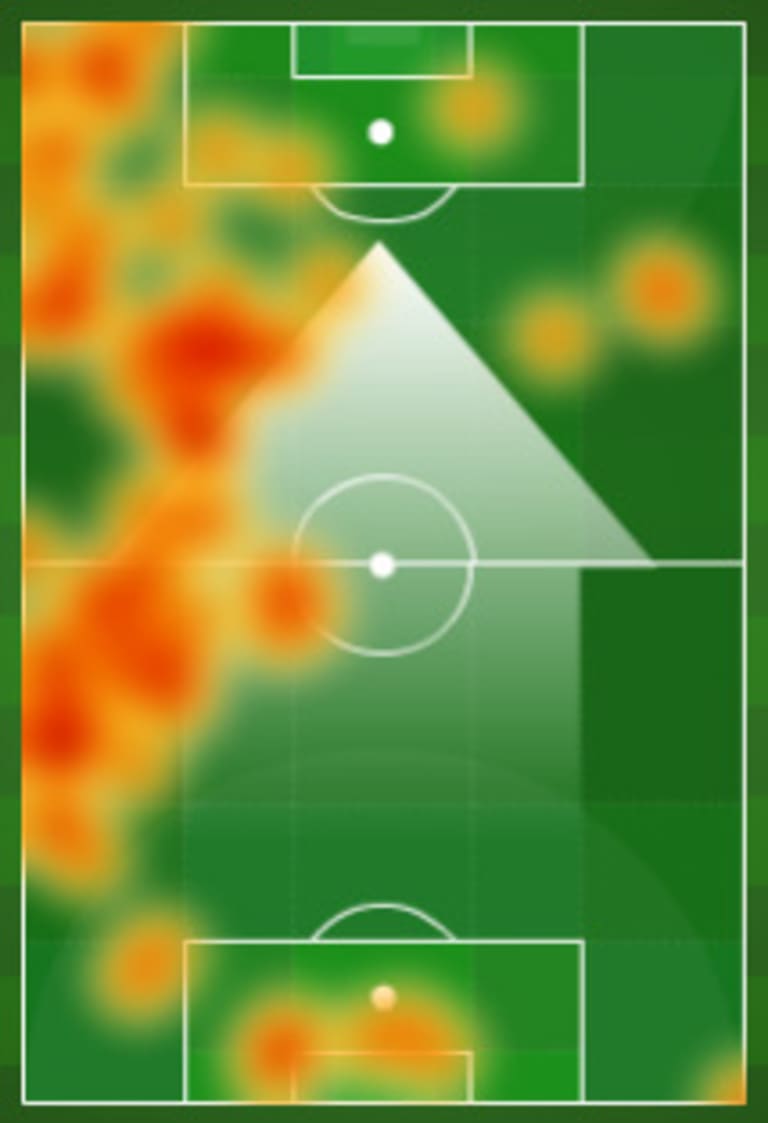Upon his arrival in the Rose City, Portland Timbers head coach Caleb Porter carried a vision of crafting a team that played a high-pressing style. But what does that mean exactly? Much has been made about the team’s solid backline play through the season with 15 shutouts, including an MLS record 11 clean sheets at home, but with Porter’s system a high-pressure style starts at the top. It is a strategy that requires forwards to act as the initial line of defensive pressure, forcing the opposing team’s players and the goalkeeper into making quick decisions as one or more Timbers player are bearing down, racing to apply pressure.
Wallace's heat map vs. Colorado, Sept. 20

Not always looking to steal the ball, the high pressure is dually meant to force snap decisions from the opposing team in their own half, helping to ignite a quick-strike Timbers attack. Portland’s forwards who have displayed their willingness to defend and understand their individual roles in Porter’s system throughout the season, consistently rank near the top of the list in ground covered each match.
To give an idea of just how much distance Timbers forwards have covered in some games this season, take a Sept. 20 home match against the Colorado Rapids at JELD-WEN Field as a prime example. According to Match Analysis software, Rodney Wallace, who lines up on the left side in Portland’s three-forward formation, finished the match with a team-high 6.89 miles covered.
More simply, he ran from JELD-WEN Field in downtown Portland up to Delta Park near the banks of the Columbia River. Or if you think in more vertical terms, Wallace covered three-and-a-half times the elevation of majestic Mt. Hood (which rises 11,249 feet).
That match against Colorado is a clear representation of Porter’s desired high-pressing style leading directly to a goal.
Armchair Analyst: Timbers' high-pressure style
In the 13th minute of the match, Rapids defender Drew Moor gained possession of the ball near the right side of the Colorado penalty box when center forward Maximiliano Urruti started sprinting in from Moor’s left side, forcing the Colorado defender to deliver a hastily made clearance. The sloppy pass was alertly intercepted by Wallace and headed straight to midfielder Diego Valeri to jumpstart a quick attack. In mere seconds, Valeri collected the pass, took a couple touches toward the penalty box and deftly chipped Rapids goalkeeper Clint Irwin for what would stand as the game-winning goal in a 1-0 win.
During the first half against Colorado, Urruti covered the third-farthest distance of any Timbers player, logging 3.37 miles – just a bit more than your typical 5K run – while directly influencing the game-winning goal.
While Timbers forwards don’t typically log the most distance in a match – that distinction usually belongs to midfielders Will Johnson and Diego Chara with outside backs Jack Jewsbury and Michael Harrington not far behind – it’s the willingness of the team’s attacking players to put in the work on defense that helps disrupt their opponents.
Armchair Analyst: Johnson as modern attacking midfielder
In the case of Johnson and Chara, they typically cover between six-and-a-half to seven miles in a match, which works out to running a full marathon or more during each month of the season. They are true box-to-box midfielders as they push the game forward in attack and then become destroyers to break up opponent forays in defense. According to Opta, Chara finished ranked sixth in MLS with 183 tackles plus interceptions. The Colombian midfielder showed his tenacity in winning balls with 115 tackles, combined with 68 interceptions. Johnson finished the season with 118 tackles plus interceptions (76 tackles, 42 inteceptions).
Another excellent example of the team’s high-pressing nature, Valeri’s pressure and awareness in the 82nd minute against Toronto FC on Sept. 7, helped the Timbers turn a 1-0 lead into what eventually ended in a 4-0 rout at JELD-WEN Field when he capitalized by pressuring the Toronto FC defense in their own half of the field. Valeri jumped on a poor first touch by Toronto’s center back and quickly tapped a pass to Rodney Wallace, who scored the team’s second goal.
Valeri creates goal for Wallace
While Valeri may not cover as much ground as his midfield brethren, it is his ability to make plays from that central spot and serve as a key pivot on the transition both in attack and defense. He makes use of the team’s high pressure to find the outlet or final pass to cut open the other team’s defense.
With Jewsbury and Harrington also covering loads of space – a combined average of 6.3 miles per game – they’re helping overload the outside channels to bring even more pressure into the attacking third. Johnson and Chara’s awareness in midfield is key as they help provide cover for when Jewsbury or Harrington press forward, not to mention the central defenders of Pa Modou Kah and Futty Danso being keenly observant of what is happening in front of them. They, and Donovan Ricketts behind them, may not put on the same mileage, but their vision to keep the ball moving forward is essential.
The willingness of the team to buy into this philosophy, to put in the work during training and in games and to understand their individual roles within the overall framework, plus their belief in each other has led the Timbers to the precipice of reaching the club’s first-ever MLS Cup. Ninety or more minutes against Real Salt Lake stand in Portland’s way of making MLS Cup on Sunday (6pm PT, ESPN / 750 The Game), but there’s no question the Timbers will cover any distance in an effort to reach the final.












